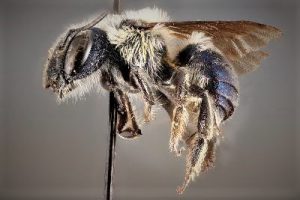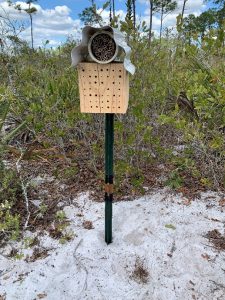
Who hasn’t heard about the rediscovery of the rare blue calamintha bee in Florida, most likely thought to be extinct?
It would surprise me if you hadn’t heard because this little blue ball of wonder has generated a global buzz after being located again last March in Highlands County by Dr. Chase Kimmel. Dr. Kimmel is a Postdoctoral Associate with the Florida Museum of Natural History. He found the native bee in three of its previously known four locations in the southern portions of the Lake Wales Ridge. The fourth location has since been developed. In 2015 a petition was submitted to add the Osmia calamanthae to Federal Listing as an Endangered or Threatened Species. But more information was needed to determine if the bee would qualify.
The State of Florida reached out to Dr. Jaret Daniels, a University of Florida insect conservation specialist and Kimmel’s mentor. More information was requested on the bee’s biology, ecology, and distribution. Two years of grant funding for research allowed Daniels and Kimmel to jump into action. They devised a plan to survey a large portion of the Lake Wale’s Ridge where the bee’s main food source, Ashe’s calamint, grows. Thousands of hours of surveys resulted in a promising discovery. The bee was found in seven additional locations. This expanded the known range from about 16 square miles to over 200 miles.
The endemic Ashe’s calamint grows in pine scrub habitats. Those habitats have been disappearing rapidly due to development and agricultural use. Herbicide and pesticide drift also create problems for the habitats. Flowers of Ashe’s calamint are thought to be the main food source utilized by the bees for nectar and pollen. It is a known fact that the blue calamintha bee has a unique way of gathering that pollen. Sticking its head within a flower it bobs up and down causing the pollen to be released onto facial hairs that collect and hold on to it. The facial hairs and bobbing technique are unique to the blue calamintha bee and are important identifying characteristics. Dr. Kimmel has devised a safe way to capture the bees that allows him to collect pollen samples from their bodies. The pollen will be tested to identify what other plants the bees may be visiting.

Nesting behavior hasn’t yet been observed in the blue calamintha bee. Osmia species are known as solitary bees. They do not raise their young in colonies like honeybees. Instead the females choose protected hollow tubular cavities in which to lay their eggs. Dr. Kimmel set up 42 nest boxes at various sites that collectively have about 300 different choices for nesting materials and cavity sizes. The boxes are made from untreated wood with pre-drilled holes of various diameters as well as PVC pipe and reeds of different sizes. The boxes have become occupied but it will not be known what species has used them until the adults emerge in the spring of 2021.

Dr. Daniels shared these updates with the UF/IFAS Extension Polk County Master Gardener Volunteers in July via a Zoom meeting. He enthusiastically exclaimed surprise at the attention this discovery received from media coverage around the world. Soon after the news came out, thousands of emails from all over the country began arriving at his office expressing interest and curiosity. Many writers attached photos of “blue bees” from their yards wishfully hoping they also had one of the rare creatures in their vicinity. Unfortunately, not.
Even though it is unlikely for those of us living in central Florida to have this rare creature visit our yard I urge people to get out and start looking anyway. You may never see the blue calamintha bee but the least that could happen is you would learn more about the fascinating world of nature taking place in your own back yard.
Rachel Mallinger, an associate of Dr. Daniels, has created a clear and helpful guide for identifying the blue bee and other similar bees that you might encounter. Visit her site at: https://blogs.ifas.ufl.edu/entnemdept/author/rachelmallinger/ Open her post entitled Which Blue Bee is Visiting my Florida Landscape? Have fun!
Photo credits used with permission: Blue Calamintha Bee specimen from Florida Museum of Natural History; Ashe’s calamint (Calamintha ashei) and bee nest boxes. Photos by Chase Kimmel.
This article was written by Master Gardener Volunteer Cathy Butcher under supervision of the Master Gardener Volunteer Coordinator and Residential Horticulture Agent Anne Yasalonis.
For more information, contact UF/IFAS Extension Polk County at (863) 519-1041 or visit us online at http://sfyl.ifas.ufl.edu/polk. The Plant Clinic is open Monday-Friday, 9:00 am-4:00 pm to answer your gardening and landscaping questions. Visit us in person, give us a call, or email us at polkmg@ifas.ufl.edu.
If you are not in Polk County, Contact your local UF/IFAS Extension Master Gardener Volunteer Plant Clinic.
The Florida Master Gardener Volunteer Program is a volunteer-driven program that benefits UF/IFAS Extension and the citizens of Florida. The program extends the vision of the University of Florida/Institute of Food and Agricultural Sciences, all the while protecting and sustaining natural resources and environmental systems, enhancing the development of human resources, and improving the quality of human life through the development of knowledge in agricultural, human and natural resources and making that knowledge accessible.
An Equal Opportunity Institution.
 0
0
